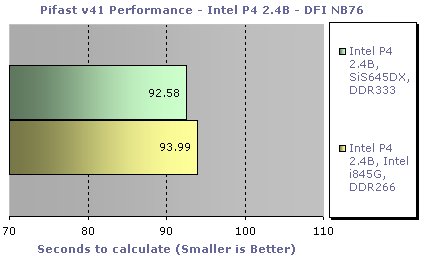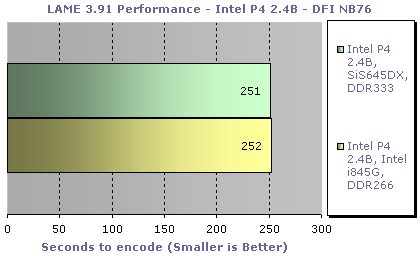|
These 3 benchmarks focus more on CPU and memory bandwidth, especially SETI with regards to the latter. CPU performance is more critical in Pifast and LAME with LAME being almost entirely CPU bound.
Lets look at Pifast first. Calculating Pi to 10 million decimical places is a test for any computation engine, never find the FPU unit of a modern day x86 implementation such as the P4. CPU performance is king here, don't look for much variation between the two systems as we hammer the FPU performance of the 2.4B.

i845G and the DFI is 1.5 seconds slower here and we put that all down to memory bandwidth differences between the two systems. Not much of a difference over the life of the benchmark but a difference none the less.
Lets look at LAME as we encode Fat Boy Slim again, hope he doesn't mind! We are CPU bound entirely here so chipset level performance is irrelevant providing it lets the host processor work correctly.

A measly 1 second difference after the average was taken means a 0 second difference in the real world. The DFI provides a stable platform for the processor here.
Lastly, our 3hr memory stresser, SETI. We analyse a single standard unit here and the CPU is moving masses of data constantly between CPU and memory so memory performance is important. Expect the SiS to win with its superior bandwidth.

~60s difference after 3 hours may not sound a lot but for dedicated SETI crunchers it all adds up. In that respect the SiS is a better platform due to increased memory bandwidth but you really need the bandwidth to notice the difference. In 95% of real world cases using the host processor, you wont care.
Doing media work, a forte of the Pentium 4, is one of the cases where the extra memory bandwidth will come in handy and in that case i850 and RAMBUS may be a better choice, although again you really have to require the bandwidth before moving to that platform.
Lets comment on the performance overall and take a look at the onboard graphics performance or at least comment on it!
|